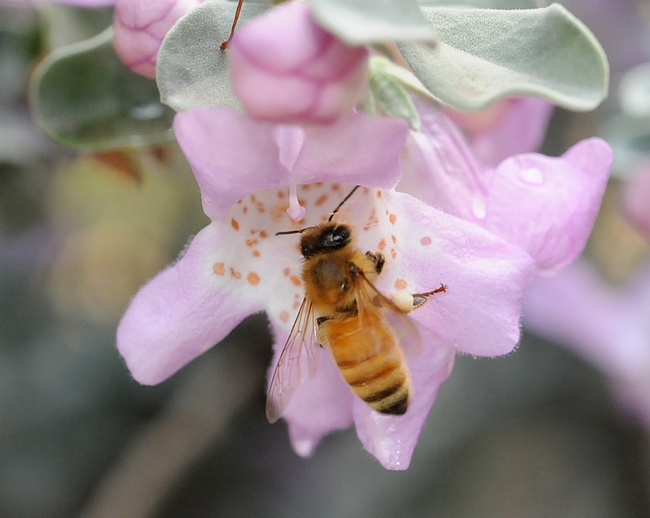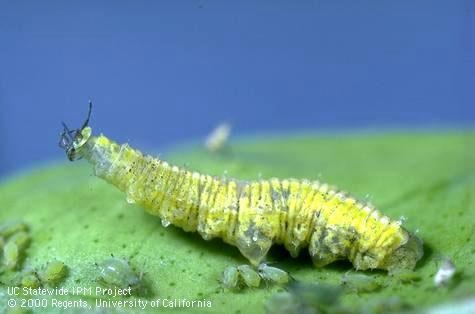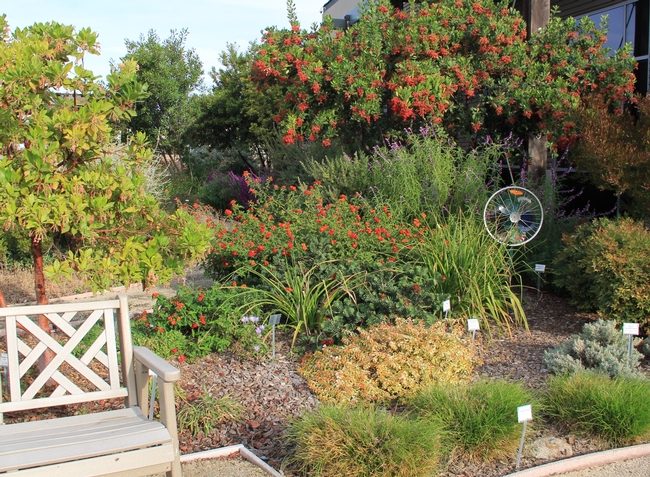 honeybees find abundant nectar in the tubular flowers of Texas sageThe bees are out.
honeybees find abundant nectar in the tubular flowers of Texas sageThe bees are out.

I don't know if you've noticed, but they have actually been buzzing around since the first fruit trees blossomed in February. There has been a lot of press coverage about bees, especially about Colony Collapse Disorder and the critical importance of bees to California Agriculture. Haagen-Dazs even partnered with UC Davis Bee Biology Department in 2009 to create a Honey Bee Haven, an educational garden open to the public to inform people about the importance of bees to our food systems and to inspire people to use bee-supporting plants in their own gardens. We all have a roll to play in making conscious decisions to support the bee and other pollinator populations in California.
What does that have to do with pesticide applications?
I was recently asked my advice about applying a common tree insecticide drench product that contains the active ingredient imidacloprid. The homeowners association member who asked advice wanted to prevent aphid infestations before they happened by drenching in early spring as the leaves were emerging. I recommended against this. So what is the problem?

When you use these broad-spectrum killers as prevention, you set up a system that never reaches a balance of pests and predators/parasites, and you end up being completely dependent on the repeated use of chemicals while creating a garden environment devoid of healthy wildlife.
So, what do you do if you do have a serious aphid issue?
You have several choices, but you should try combining tactics for the best control. First, if you have certain plants that seem to be more highly attractive to aphids, like crape myrtles, be sure to watch for ants and control these with baits (like those containing boric acid) they take back to the nest. Ants will protect and farm the aphids making the infestations worse, but controlling them with baits is highly effective and non-toxic to non-target species.

Don't be too quick to resort to chemical sprays. In spring, the aphids will show up about two weeks earlier than the ladybugs. If you can hold on, the predators will show up and take care of the issues without the need for sprays. In the meantime, you can knock down the highest populations with hard sprays of water from a hose with a nozzle.
If you have a really serious issue of scale or aphids in trees that is causing heavy honeydew drip on cars, pavements, and other plants leading to sooty mold and unhappy people for several years in a row, then it is time to consider a treatment. It should never be applied when bee populations are noticeable in the area, and it shouldn't be used for years in a row. Usually, a properly timed application will be enough to get the problem under control in a single year, allowing the beneficial populations to resume control in subsequent years. If the issue is on shrubbery or roses, then consider using organic sprays like those derived from chrysanthemums (pyrethrins) that kill on contact but have no residual toxicity. But be forewarned that if you spray bees directly, they will also be affected.
Taking a measured approach that considers all the factors in the environment and uses a combination of methods is the best way to maintain healthy landscapes without the need for regular use of highly toxic pesticides. When we protect the bees, we protect ourselves.